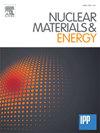Boronization with tungsten plasma-facing surfaces in ASDEX Upgrade
IF 2.7
2区 物理与天体物理
Q1 NUCLEAR SCIENCE & TECHNOLOGY
引用次数: 0
Abstract
With the switch to tungsten for the ITER plasma facing components, wall conditioning techniques such as boronization are gaining new interest. As AUG uses tungsten plasma facing components as well as boronization, the present results are summarized and reviewed in this paper. In AUG it has been shown how to operate without boronization, but conditioning by B coating through a glow discharge (boronization) is now the standard start-up procedure. The properties of the amorphous boron hydride layers, produced by boronization, depend on the discharge conditions and the residual carbon content. At AUG, chemically active layers are required to getter oxygen and deuterium. After initial conditioning, further boronization is only required for some special scenarios. The lifetime of these subsequent coatings is about 20–30 discharges, after which a new coating or a boron powder injection is required to refresh the conditioning for these special scenarios. The main effect of boronization is to reduce tungsten sputtering from the main chamber limiter by reducing impurities. As the layers are chemically active, they react with air during venting, producing unstable whitish layers that are slowly vanishing. Specifically, they cannot be studied by scanning electron microscopy or ion beam analysis, because under vacuum conditions they are lost even faster. The remaining layers are long-term stable, but contain on average only 4.1 % of the boron injected during the boronizations. This remobilisation reduces the deuterium inventory in the layers to about 0.1 % of the input during the campaigns.
硼化钨等离子体表面在ASDEX升级
随着ITER等离子体面组件转向钨,硼化等壁调节技术正在获得新的兴趣。由于氩弧焊采用了钨等离子体表面元件和硼化处理,本文对目前的研究成果进行了总结和评述。在8月份,它已经展示了如何在没有硼化的情况下运行,但通过辉光放电(硼化)的B涂层调节现在是标准的启动程序。硼化制备的非晶氢化硼层的性能取决于放电条件和残余碳含量。在AUG,化学活性层需要吸收氧气和氘。初始调理后,只有在某些特殊情况下才需要进一步渗硼。这些后续涂层的使用寿命约为20-30次放电,之后需要新的涂层或硼粉注入以刷新这些特殊场景的调理。渗硼的主要作用是通过减少杂质来减少主腔限制器的钨溅射。由于这些层具有化学活性,它们在排气过程中与空气发生反应,产生不稳定的白色层,这些层正在慢慢消失。具体来说,它们不能通过扫描电子显微镜或离子束分析来研究,因为在真空条件下它们丢失得更快。其余层是长期稳定的,但平均只含有硼化过程中注入的4.1%的硼。这种重新调动将各层的氘库存减少到战役期间投入的0.1%左右。
本文章由计算机程序翻译,如有差异,请以英文原文为准。
求助全文
约1分钟内获得全文
求助全文
来源期刊

Nuclear Materials and Energy
Materials Science-Materials Science (miscellaneous)
CiteScore
3.70
自引率
15.40%
发文量
175
审稿时长
20 weeks
期刊介绍:
The open-access journal Nuclear Materials and Energy is devoted to the growing field of research for material application in the production of nuclear energy. Nuclear Materials and Energy publishes original research articles of up to 6 pages in length.
 求助内容:
求助内容: 应助结果提醒方式:
应助结果提醒方式:


